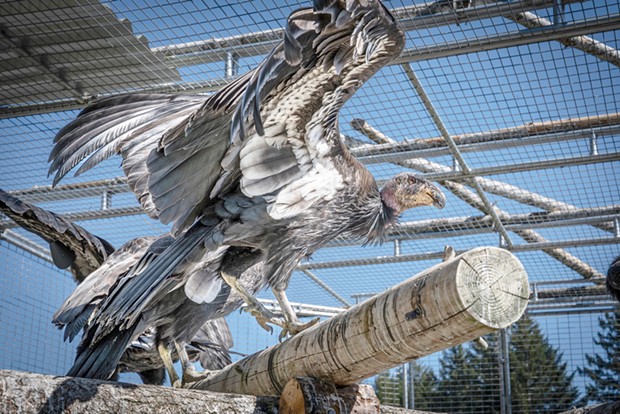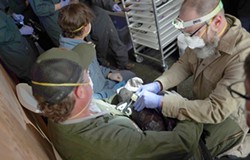Condor Check-in
The North Coast flock expands its range as a new cohort of birds waits in the wings
By Kimberly Wear [email protected] @kimberly_wear[
{
"name": "Top Stories Video Pair",
"insertPoint": "7",
"component": "17087298",
"parentWrapperClass": "fdn-ads-inline-content-block",
"requiredCountToDisplay": "1"
}
]
The North Coast's 11 condors "looked great" after undergoing recent medical exams, according to an update from the Northern California Condor Restoration Program, a Yurok Tribe-led effort to bring the bird known as prey-go-neesh back to the upper reaches of the endangered species' former range.
The annual spring evaluations are not only an opportunity for the program's team to do hands-on assessments, including taking blood samples to test for potential health threats, but to make any needed repairs to the birds' satellite transmitters and identification tags.
In the May 16 update, NCCRP Manager and Yurok Wildlife Department Senior Biologist Chris West noted none of the condors had any "detectable levels of lead in the blood."
As an apex scavenger, condors serve as "nature's clean-up crew," scouring the landscape of large carcasses and, in turn, helping prevent the spread of diseases. But that ecological role also makes the largest bird in North America — boasting a nearly 10-foot wingspan and weighing 20 pounds or more — vulnerable to being poisoned by lead ammunition fragments in the carrion, which accounts for about half of condor deaths in the wild.
In October, one of the local condors needed to undergo treatment at the Sequoia Park Zoo and five others were found to have elevated levels of the toxin after they ate remains of an elk killed by a poacher in Redwood National and State Parks, which was believed to be the contamination source.
And that came after a close call a year earlier, when two tainted elk were found within the fledgling flock's range — with just one of the poached animals containing enough lead bullet fragments to kill several condors, according to the Yurok Tribe. At the time, West described the incident as being "as close as you can get to a worst-case scenario."
(It should be noted that those near misses came despite California banning the use of lead ammunition for hunting in 2019 and the Yurok Tribe spending years working to educate hunters about non-lead ammunition options before ever bringing the condors to the North Coast.)
But humans and the birds' natural predators aren't the only dangers lurking for condors. Last year, an avian flu outbreak killed at least 22 members of the Southwest population living in Arizona and Utah.
With a recently approved vaccine now in hand, the NCCRP team took advantage of this recent check-up session to also administer the two-dose series to the eight eldest members of the flock.
Those include Ney-gem' 'Ne-chween-kah (She Carries Our Prayers, A0), Hlow Hoo-let (Finally, I/We Fly, A1), Nes-kwe-chokw' (He Returns/Arrives, A2) and Poy'-we-son (The One Who Goes Ahead or Leader, A3) as well as Cher-perhl So-nee-ne-pek' (I Feel Strong, A4); and Neee'n (Watcher, A5), 'Me-new-kwek,' (I'm Bashful or I Am Shy, A6) and He-we-chek' (I Am Healthy or I Get Well, A7).
In November, the newest members, Pey-gel (Fighter, B0), Pue-leek (Downriver, B1) and Pey-cheek (Upriver, B2), became the first vaccinated condors in the nation to take flight in the wild after being inoculated as part of a trial program at the Los Angeles Zoo.
According to the U.S. Fish and Wildlife Service, the vaccine "should provide some level of protection from mortality if the birds are exposed to the virus, and likely decrease the degree to which an individual becomes ill."
In a recent email to the Journal, Tiana Williams-Claussen, director of the Yurok Tribe Wildlife Department said, "all of the North Coast's condors are now either fully or partially vaccinated, and the A-series birds currently in holding are slated to receive their second dose soon, to be released soon after, presuming all goes well."
She added she expected the condors currently being held in the release enclosure to be once again soaring over the North Coast by mid-June.
California condors were declared endangered back in 1967, when fewer than 100 survived outside of zoos. But as the wild population continued to dwindle over the next 20 years — with only 22 remaining in a small pocket of mountainous area in Southern California — they were placed into captive breeding programs in 1987 in a race against time to save the bird from extinction.
As of December, the latest numbers available from USFW, the nation's condor population now stands at 561, with 344 flying free as part of restoration efforts, including 195 birds in California.
Among the latter are the North Coast's 11 birds, with the condors' return to the region in 2022 culminating decades of work by the Yurok Tribe to bring back prey-go-neesh —a bird that the tribe and many Indigenous cultures consider sacred — to once again soar over their ancestral lands.
In the two years since A3 and A2 became the first of the flock to spread their wings in the skies over Yurok country after a century-long absence, the birds mostly stuck close to the release site around the Bald Hills area of the Redwood National and State Parks, a partner in the restoration endeavor.
But things started picking up speed around April, with the birds "consistently expanding their range week after week," according to a social media post by the NCCRP.
"Within their new range, the condors have flown over Tolowa Dee-ni', Yurok, Karuk, Hupa, Chilula, Wiyot, Wintu, Pomo, Bear River Band of Rohnerville Rancheria, and neighboring traditional tribal lands, including Eureka, Blue Lake, Arcata, Ferndale, Hoopa, Orleans, Klamath, Crescent City, Berry Glenn, Dinsmore and Rio Dell, amongst other locations," the NCCRP states.
(Read more about a recent sighting in this week's Get Out "Condors Over Arcata" on page 25.)
Williams-Claussen told the Journal those journeys have also seen the condors scavenging more in the outside world.
"We are happy to see them expanding, and to be finding more wild forage," Williams-Claussen said. "We are still consistently providing them food because we want to keep them tuned into the management facility, so that they keep returning for their health checks, but they definitely have been taking advantage of that wild food."
Another milestone for the flock is slated to take place sometime this summer, when seven more birds are expected to join the fold.
"We are currently still in discussion of final placement of birds throughout the current California condor recovery program, but it does look like we are still to receive our two delayed birds (due to the avian flu outbreak) from last year, coming from the Oregon Zoo, as well as an additional five to be coming from the LA Zoo," she said.
As to the potential big step of a homegrown boost in the local condor population's numbers, don't get any hopes up yet for the fluttering of little prey-go-neesh wings.
Aside from viruses and man-made dangers, one of the other main challenges to the condors' survival comes down to simple biology — the birds are late bloomers in the avian world.
On top of that, condors are highly social and heavily dependent on elders showing them the survival ropes. So, with no adult birds around to act as examples, the mating game might take a little longer.
But even if the North Coast flock's oldest members are quick on the uptake, Williams-Claussen noted those birds are just 5 years old right now.
"Typically, condors don't find mates until 6 to 8 years old, so we've got a bit of time yet," she said. "That said, you can really see the difference in maturity between the 5 and 4 year olds, which is interesting to observe."
Kimberly Wear (she/her) is the Journal's digital editor. Reach her at 442-1400, extension 323, or [email protected].
more from the author
-
Eureka Man Killed in SoHum Crash
- Jul 1, 2024
-
Caltrans Selects Tunnel Option for Last Chance Grade
- Jun 18, 2024
-
Kyle Steven Wear: 1970 —2024
- Jun 16, 2024
- More »
Latest in News
Readers also liked…
-
Through Mark Larson's Lens
A local photographer's favorite images of 2022 in Humboldt
- Jan 5, 2023
-
'To Celebrate Our Sovereignty'
Yurok Tribe to host gathering honoring 'ultimate river warrior' on the anniversary of the U.S. Supreme Court ruling that changed everything
- Jun 8, 2023


































